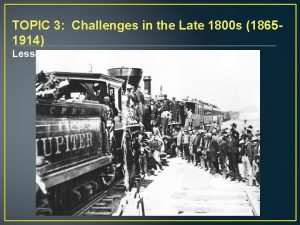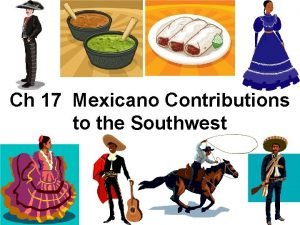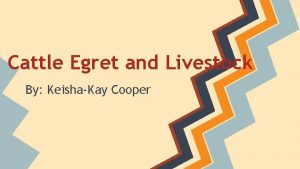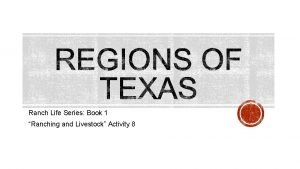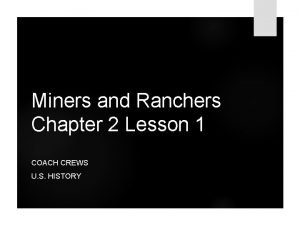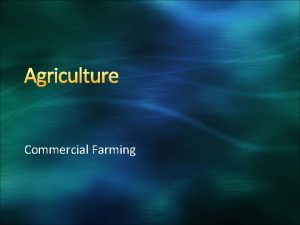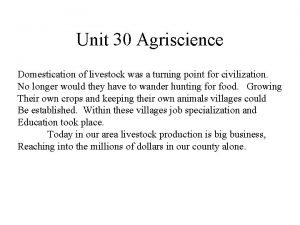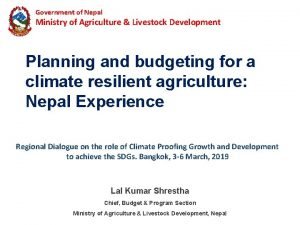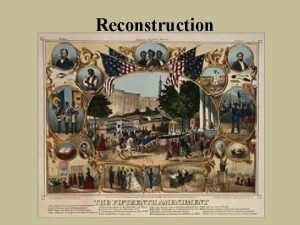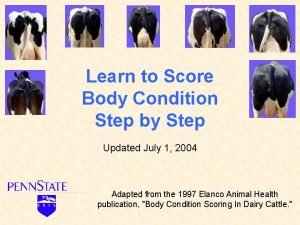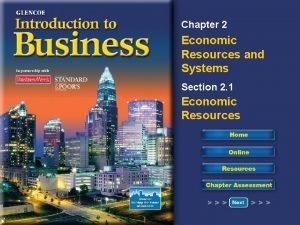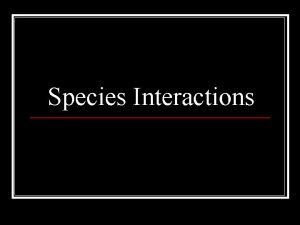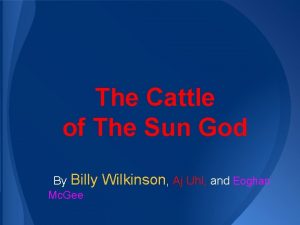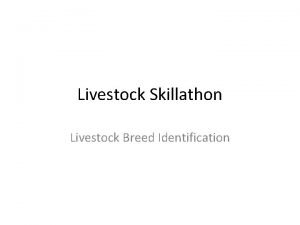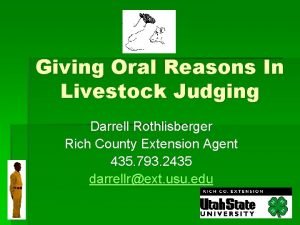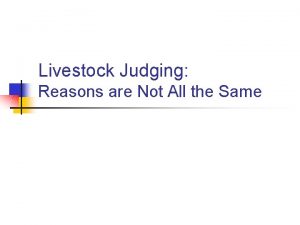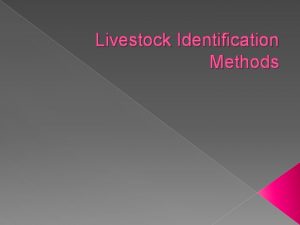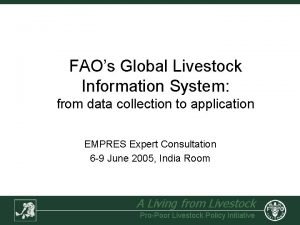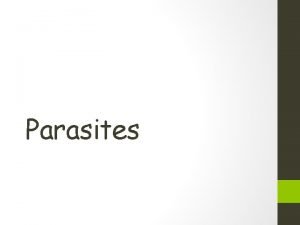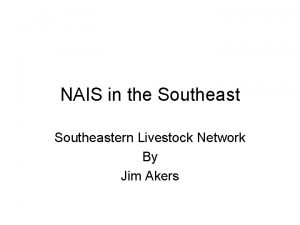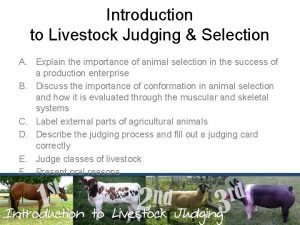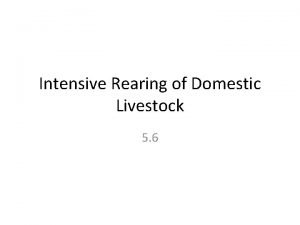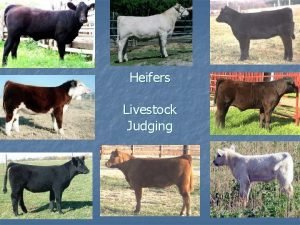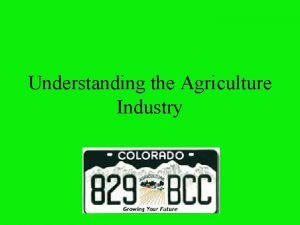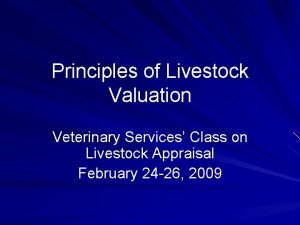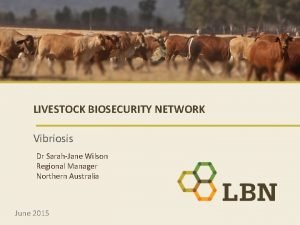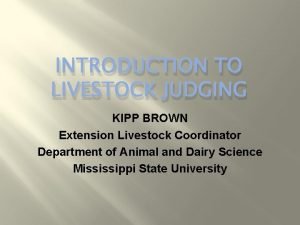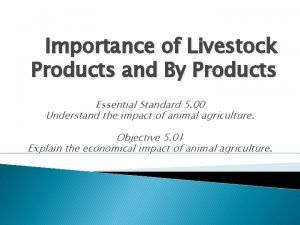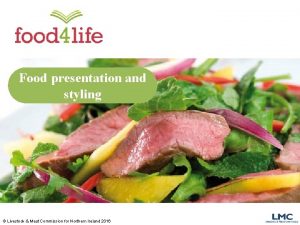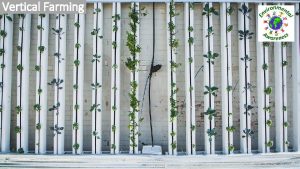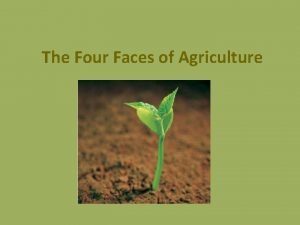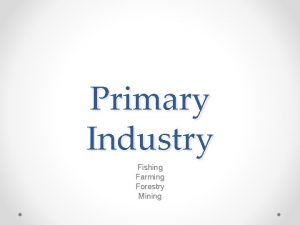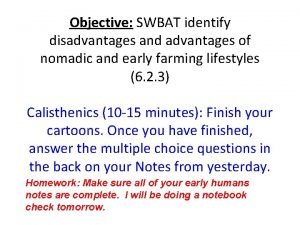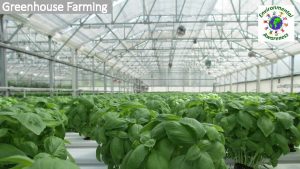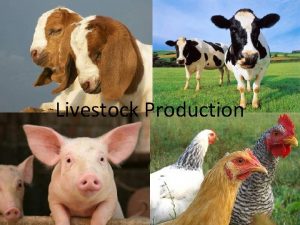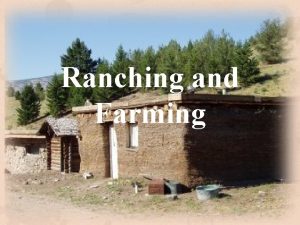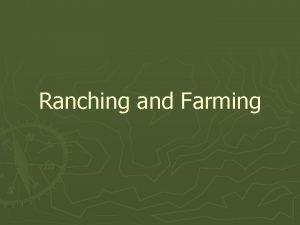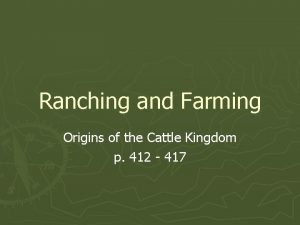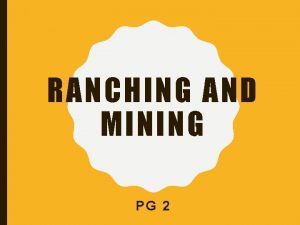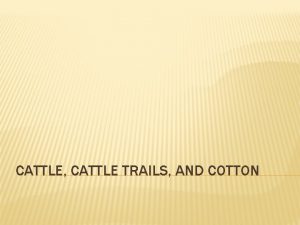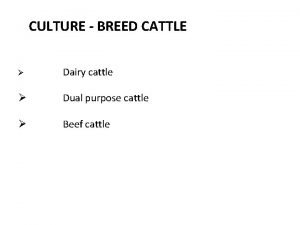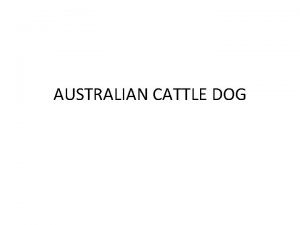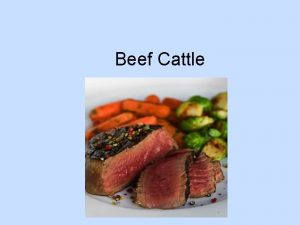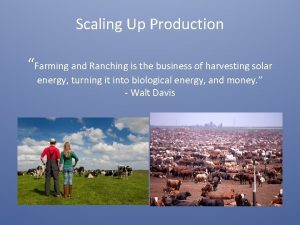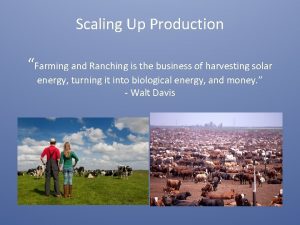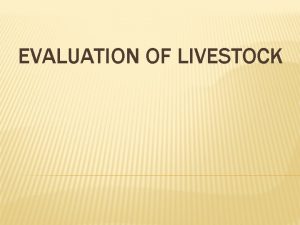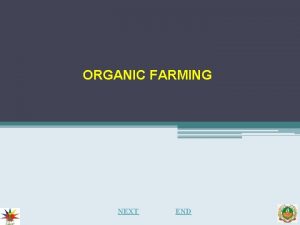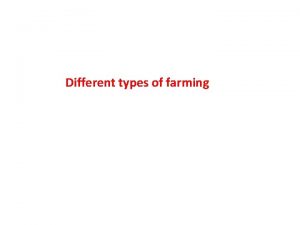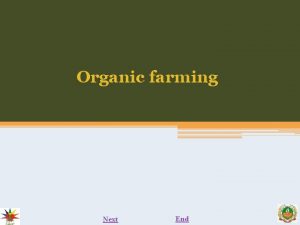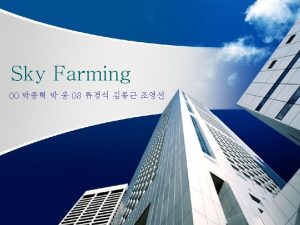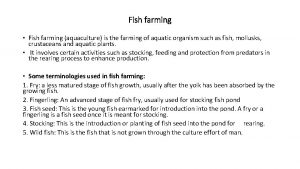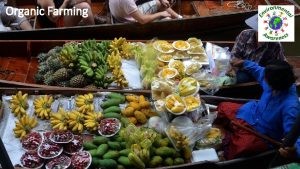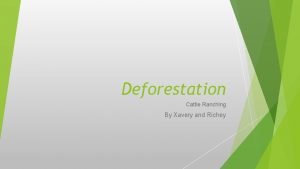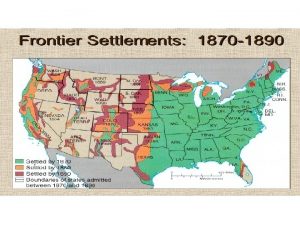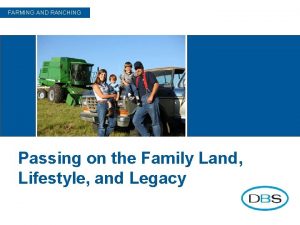Livestock Production Livestock Production Cattle ranching and farming














































- Slides: 46

Livestock Production

Livestock Production • • • Cattle ranching and farming Dairy farming Hog and pig farming Sheep and goat farming Poultry and egg production Animal aquaculture

Cattle Ranching and Farming • Two types of livestock cattle: beef and dairy • Beef cattle are raised for meat • Dairy cattle are raised for milk

Beef Cattle Production • There are 3 main systems of beef cattle production in the U. S. : – Cow-calf production – Stocker operations – Feedlot production

Cow-Calf Production • Breeding cows with bulls (either naturally or through artificial insemination) to produce a calf crop (calves which are then sold to market) – Involves commercial and purebred breeders

Cow-Calf Production • Commercial producers raise steers and heifers that are sold at weaning, destined to become slaughter animals • Purebred breeders raise calves destined to become part of breeding herds or bulls from which semen can be collected for artificial insemination

Stocker Operations • Stocker operations utilize available forages or roughages to grow cattle from weaning until weight-ready for entrance into a feedlot

Feedlot Production • Feedlot production involves feeding cattle highly concentrated rations in a large confinement facility. • When cattle are deemed market ready, they are sold to a meat processor for conversion into consumer product. • There are commercial feeders and farmerfeeder producers

Feedlot Production • Commercial feeders are generally quite large, and owned by corporations – Capacities of up to 40, 000 to 100, 000 head of cattle • Farmer-feeder productions have capacities of less than 1, 000 head, and make up about 30% of the feedlot cattle in the U. S.

Feedlot Production

Management Practices • There are many management practices that U. S. cattlemen use to improve their cattle's value: – Identification – Castration – Dehorning – Implanting – VAC vaccination

Identification • Cattle identification should provide individual, permanent identity, and information about each animal – Tattoo and ear tag – Hot or fire branding – Freeze branding – Electronic ear tags

Castrating Bull Calves • Castration is removing the testicles from bulls. • Why? – Steers are more docile in temperament and less restless, fatten quicker, and can be mixed with females in pasture or lots. – Castration eliminates the possibility of inferior bulls breeding with the cows.

Dehorning • Dehorning is the process of removing the horns from cattle. • Why? – Dehorned cattle sell for higher prices because the packer knows it will require less carcass trimming. – Dehorning reduces injury to men and horses when working the cattle. – Dehorned cattle require less shed and feeding space.

Dehorning Cattle

Implanting • Implanting cattle is the process of placing a pellet of steroid hormones into the ear of young calves to accentuate growth potential. • Why? – Increases weaning weight

Value Added Calf Vaccination Program • Stress caused by weaning, transportation, and changes in environment lower a calf’s resistance to disease. • Vaccination programs are designed to get calves ready to enter the marketing and production channels after they leave a ranch.

Diseases Brucellosis (bangs disease): Caused by a bacteria -No treatment Hemorrhagic septicemia (shipping fever): caused by stress, virus, infection, or bacteria. -Can be treated with antibiotics or a vaccine

Diseases Keratoconjunctivitis (pink eye): caused by a bacteria -can be treated with antibiotics Foot rot (sore foot): caused by bacteria and damp hooves -can be treated with bluestone solution

Diseases Tuberculosis (TB): caused by a bacterium -No treatment Bovine Papillomatosis (warts): caused by a virus -can be treated by toothpaste, wart pinching, twisting close to the base

Importance of the Beef Industry • Each day, 75 million people eat beef in the U. S. – 1 steer can provide 540 servings of beef, potentially impacting 540 consumers • Every dollar of cattle sales generates another $5 -$6 in economic activity • Cattle production provides the most jobs in agriculture – Provides 1 million direct jobs and 2 million related positions

Dairy Farming • Dairy farming is the long term production of milk – usually from dairy cows

Breeds of Dairy Cows Ayrshire • Hardy cows, good grazers, good udders Brown Swiss • Oldest dairy breed, late maturing

Breeds of Dairy Cows Guernsey • Frail cows, highest calf mortality rate Holstein • Top producer, most popular dairy cow in U. S. , poorest grazer, lowest fat solids

Breeds of Dairy Cows Jersey • Smallest cow, richest milk, popular due to heat resistance, highest fat solids Milking Shorthorn • Late maturing, less than. 25% of this breed is in U. S.

Milk Production • A dairy cow will produce between 6, 000 and 35, 000 pounds of milk per year – Depends on breed, breeding, nutrition, etc… • Bovine somatotropin is a growth hormone given to cows to increase milk yield. • A top individual cow with 2 x daily milking produced 18. 8 gallons of milk per day (59, 300 lbs per yr)! • A top individual cow with 3 x daily milking produced 19. 2 gallons of milk per day (60, 380 lbs per yr)!

Milk Production • The average dairy cow in the U. S. today produces more than 2 x the milk of a dairy cow in 1955 • Why? – Advances in management of dairy cattle herds – Advances in nutrition – Advances in genetics

Management Practices • • Feed and feeding Free stall barn Feed lanes Calf hutches Milking procedures Milking machines Milking parlors Milk storage

Feed and Feeding • Most milking herds are fed a mixture, called a Total Mixed Ration, or TMR • TMR are based on least cost formulation • Ingredients: corn silage, whole cottonseed, cottonseed meal, wet brewers grain, grain concentrates, and fat (as an energy booster) • Advantage of TMR: cows can’t sort the ingredients when eating, so each bite is wellbalanced.

Free stall Barn • Freestyle barns have individual stalls bedded with sand • Provide: – Individual cow comfort and prevent other cows from stepping on udders – Cool, shady bedding in the summer, with enough ventilation to keep the cow cool

Free stall Barn

Feed Lanes • Headgates lock to allow for palpation or b. ST injections • Provide: shade to prodect feed from sunshine and rain, a place for TMR to be fed to cows, a cool place for cows (misters are often run on timers when temperatures are high) • Feed lanes are scraped at least once a day to allow for fresh feed

Feed Lanes

Calf Hutches • When a calf is removed from a heifer after birth, they are often placed in calf hutches. • Hutches prevent calf-to-calf contact and reduce the spread of disease • Hutches allow for full supervision of feeding behavior and nutrient intake • Calves are kept in hutches until they eat 4 lbs of grain per day

Calf Hutches

Milking Procedures 1. Cows washed automatically in wash rack and allowed to drip dry 2. Pre-dip udder with a 1% iodine-based spray 3. Teats wiped dry with individual paper towel 4. Each teat stripped of 2 -3 squirts of milk to check for mastitis or other abnormalities 5. Milker attached to teats and will detach when >. 5 lb/min is flowing 6. Check udder for ‘milk-out’ 7. Dip teats with an iodine-based dip with a polymer barrier included 8. Cow exits parlor

Mechanics of the Milking Machine • Milk comes out of the cow with the help of a vacuum – The vacuum is the source of pulsation on the teats • MILKING: – Vacuum is applied to the exterior of the teat, and opens the teat canal so that milk is removed – Periodic air is admitted into the space between the liner and shell to allow for pulsation, which causes a resting stage.

Milking Parlors There are 3 main types of milking parlors: • Herringbone parlor • Parallel parlor • Rotary parlor

Herringbone Parlor • Cows stand next to each other, facing away from the pit at 45 degree angles • Milkers milk the cows from the side, and have better visual contact with the cow’s udder during milking • Makes for a longer pit, more time to load and unload, and longer distances for milkers to walk

Parallel Parlor • Cows stand at 90 degree angles to the pit and are milked from the rear • Cows stand closer together so milkers have shorter distances to walk between cows • Some milkers have trouble reaching the front teats, and a cow’s tail can get in the way

Rotary Parlor • The platform on which the cows stand moves in a circle while the milkers stand in one location • Cows move very quickly so a task must be performed within 10 -12 seconds with no break between cows

Milk Storage • One day of milk (2 milkings) is stored on the farm for daily pickup • Milk is cooled and held in bulk tank • Milk is picked up by refrigerator truck – To be accepted by truck, milk must taste and smell fresh, and be 38 degrees or less • Each day, a sample of milk is taken and tested for somatic cells, bacteria, and antibodies

Diseases Mastitis: an inflammation of the udder main cause: bacterial infection *the #1 money loser for dairy farmers! Ketosis: low blood sugar main cause: weakening in metabolism of volatile fatty acids carbohydrates and Milk Fever: aka parturient paresis; low blood calcium and muscle weakness main cause: occurs at or near calving; may cause calving problems or even death -probability of occurrence increases with cow’s age; rare in first calf heifers

Calf Diseases Calf Scours: diarrhea, weakness, dehydration, rough coat main cause: E. coli, some viruses, stress Pneumonia: respiratory disease resulting from other diseases, parasites, poor nutrition, or severe weather have stressed the calf.

Dairy Importance The diary industry is important in the U. S. : • Dairy cattle are the most efficient domestic livestock in production of protein and energy • Dairy cattle provide a versatile food source: – Liquid milk, cheese, yogurt, frozen desserts (ice cream!) • Consumption of dairy products provides: – 22% of U. S. protein consumed – 76% of U. S. calcium consumed

 What contribution did mexicans make to cattle ranching
What contribution did mexicans make to cattle ranching What factors led to the
What factors led to the Mexicano contributions to the southwest
Mexicano contributions to the southwest Cattle egret and cattle symbiotic relationship
Cattle egret and cattle symbiotic relationship Books on ranch life and ranching
Books on ranch life and ranching Ranching coach
Ranching coach Sea ranching
Sea ranching Truck farming definition ap human geography
Truck farming definition ap human geography How did the spanish influence ranching in texas
How did the spanish influence ranching in texas Ranching definition ap human geography
Ranching definition ap human geography Commercial farming definition
Commercial farming definition Produksi multimedia
Produksi multimedia Agriscience unit 30 self evaluation answers
Agriscience unit 30 self evaluation answers Ministry of agriculture and livestock development nepal
Ministry of agriculture and livestock development nepal Compare and contrast sharecropping and tenant farming
Compare and contrast sharecropping and tenant farming Hooks and pins cattle
Hooks and pins cattle Hooks and pins on cattle
Hooks and pins on cattle Range cattle research and education center
Range cattle research and education center Some natural resources, such as wheat and cattle, are
Some natural resources, such as wheat and cattle, are Cape buffalo and cattle egrets relationship
Cape buffalo and cattle egrets relationship Odysseus and the cattle of the sun god
Odysseus and the cattle of the sun god Livestock breed identification swine - assessment
Livestock breed identification swine - assessment Livestock judging oral reasons
Livestock judging oral reasons Livestock judging reasons
Livestock judging reasons Livestock risk management brokers near me
Livestock risk management brokers near me Animal kingdom taxonomy chart
Animal kingdom taxonomy chart Livestock identification methods
Livestock identification methods Livestock information system
Livestock information system Parasites of livestock - vocabulary
Parasites of livestock - vocabulary Livestock network
Livestock network Livestock judging card
Livestock judging card Domestic livestock
Domestic livestock Livestock judging basics
Livestock judging basics Colorado livestock
Colorado livestock Livestock valuation methods
Livestock valuation methods Livestock biosecurity network
Livestock biosecurity network Livestock judging 101
Livestock judging 101 Livestock judging terminology
Livestock judging terminology Livestock breed identification swine - vocabulary
Livestock breed identification swine - vocabulary Livestock meat commission
Livestock meat commission Vertical farming pros and cons
Vertical farming pros and cons Pros and cons of organic food
Pros and cons of organic food Farming mining and fishing are
Farming mining and fishing are Advantages and disadvantages of nomad life
Advantages and disadvantages of nomad life Greenhouse advantages and disadvantages
Greenhouse advantages and disadvantages Sharecropping and tenant farming venn diagram
Sharecropping and tenant farming venn diagram Carpetbaggers cartoon
Carpetbaggers cartoon
